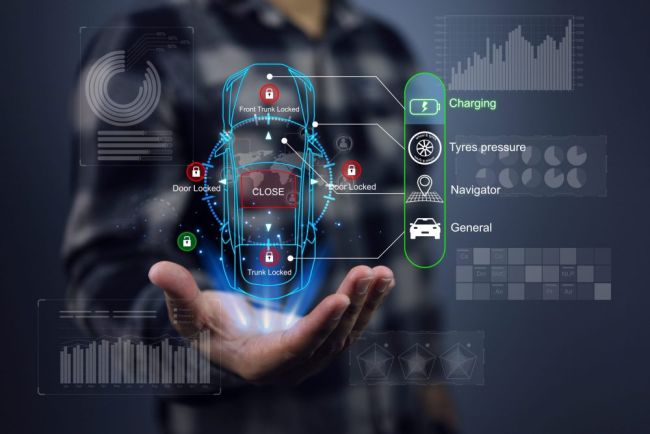
The Latest AI Advancements for Utility Fleets
Imagine a world in which you’re predicting and fixing mechanical failures before they happen. You’re coordinating maintenance schedules across hundreds or thousands of vehicles with minimal human intervention. And you’re getting detailed answers to questions about your fleet within seconds – instead of spending days pulling reports.
Is this a fleet manager’s dream? Yes. But it’s also becoming a reality with the latest versions of artificial intelligence, according to Bob Bradley, associate vice president of data science and AI engineering for Geotab (www.geotab.com).
I recently sat down with Bradley to get his outlook on AI’s impact on fleet today and what it might look like in the next 18 to 24 months. Here are the five big takeaways from our conversation.
1. Predicting Problems Before They Blindside You
“Things like predictive maintenance and collision risk are areas we’re passionate about with AI at Geotab,” Bradley said. For instance, AI can forecast parts failures by analyzing current and historical vehicle data across the entire fleet, ensuring vehicles are serviced proactively before a catastrophic breakdown.
“We’re entering a world where we have multiple AI agents working on problems together,” Bradley said. These interconnected AI systems communicate in natural language, linking platforms like telematics and maintenance.
“An agent from a fleet maintenance system can talk to our MyGeotab agents to share information and coordinate workflows, such as prioritizing repairs based on real-time data,” Bradley explained.
For safety, AI algorithms go beyond analyzing driver behavior, incorporating environmental factors like weather, traffic and road conditions, which are especially relevant for utility fleets operating in diverse regions and often in harsh environments.
“You and I as drivers may have very similar driving behavior. We may drive similar vehicles. We may do a similar job. But environmental factors could make it a little bit riskier for me,” Bradley said.
For instance, a vehicle that is being operated in harsh wintry Canadian conditions faces different risks than one in sunny Florida, even if both drivers exhibit similar habits. By factoring in these contextual elements, AI can assist in tailoring coaching and safety interventions, helping to ensure that fleet and safety managers address the right risks at the right time.
2. Getting More In-Depth, Valuable Information Faster
Fleet managers often grapple with overwhelming telematics data, but AI simplifies the process.
“Fleets have a ton of data at their disposal, and they can use that data to make informed decisions. But the challenge there, of course, is processing such large volumes of data to surface the right insights for a fleet manager, maintenance manager, whatever the case may be,” Bradley said.
AI brings that information to them more quickly. “It’s all about speed of decision-making – having the right data in front of you when you need it,” Bradley said. “This way, you can make more strategic decisions and spend less time trying to wrangle the data.”
3. Seeing the Future: Agentic and Multimodal AI
Bradley pointed to two key developments expected within the next 18 to 24 months: The increased adoption of both agentic and multimodal AI.
Bradley said that agentic AI involves “tasks being done on your behalf, work being done to support your decision-making,” such as automating routine analyses or coordinating between systems.
Multimodal AI allows users to interact with systems via text, voice or video. Take pre-trip inspections, for example. “There’s an opportunity to take your phone, walk around and have the AI help inspect the vehicle with much less manual data entry,” Bradley said. AI instantly generates and uploads the reports, improving accuracy while easing administrative burdens.
4. Ensuring Security and Privacy
The rise of multimodal AI and multiagent systems introduces new security challenges. For instance, a fleet manager might use voice commands, or a maintenance system might share insights with a telematics platform. Bradley highlighted the need for “new thoughts around user permissions on how a user can decide what an AI agent can and can’t do.”
The evolving nature of AI security requires new approaches. “We’re entering a new space with new technology that has only emerged in the last few years,” Bradley cautioned. “We want to think very thoroughly about any type of security or permissions and how the data is being used.”
5. Addressing Concerns About AI
Despite AI’s potential, Bradley acknowledged potential barriers to adoption. “This is a new world we’re entering. It just may take us a little while to make sure that, as a whole, the industry gets things right.”
Instead of fleets going all-in on AI at once, he expects the industry to take a hybrid approach. “We’ll have both types of interactions for a long time. This means gradually introducing AI – such as using AI agents like [Geotab’s] Ace for specific tasks – while maintaining familiar systems, allowing fleets to adopt new tools at their own pace.”
The Bottom Line
Where should you start with AI?
“Look for those opportunities to automate so that you can spend your time on the strategic work,” Bradley said.
In other words, begin by identifying time-intensive tasks that AI can automate, such as manual data entry for compliance reports or analyzing telematics data. Then start with small-scale AI implementations to build team confidence before scaling up, ensuring minimal disruption to your operations.

